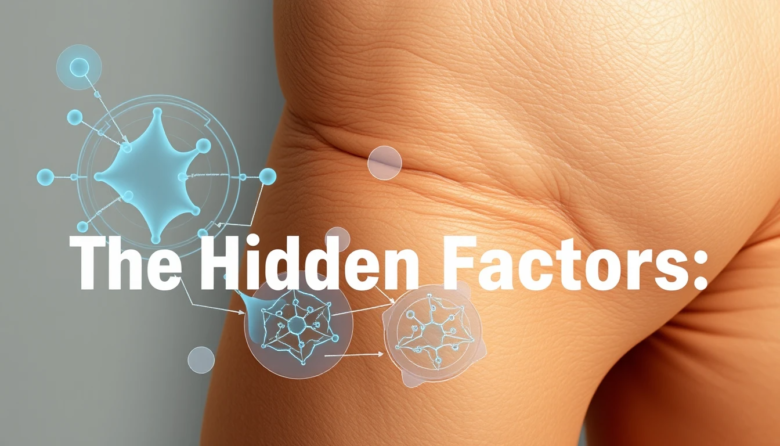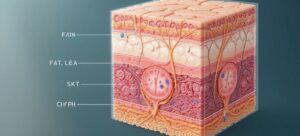Introduction
Cellulite is a term that resonates with many, yet its underlying causes remain shrouded in mystery and misunderstanding. Often described as the dimpled, lumpy appearance of the skin commonly found on the thighs, buttocks, and abdomen, cellulite is a condition that affects a significant portion of the population, particularly women. Despite its prevalence, there is a great deal of misinformation surrounding its causes, prevention, and treatment. In this article, we aim to peel back the layers of myth and reveal the scientific factors that contribute to cellulite development.
Our exploration begins with a fundamental understanding of what cellulite is, followed by a detailed examination of the biological, hormonal, and lifestyle factors that influence its formation. By presenting evidence-based insights and discussing the latest research, we hope to empower readers with a clearer picture of the hidden factors behind cellulite. Ultimately, a deeper understanding of these scientific mechanisms will provide a foundation for better prevention strategies and more informed decisions regarding treatment options.
What is Cellulite?
Cellulite is characterized by a textured, dimpled appearance of the skin that is most noticeable in areas where fat deposits push against the connective tissue beneath the skin. Although it is not considered a serious medical condition, cellulite can have a significant cosmetic impact, leading to a great deal of concern among those affected.
Anatomical Basis
- Skin Structure:
The skin is composed of three primary layers: the epidermis, dermis, and subcutaneous tissue. The outermost layer, the epidermis, provides a protective barrier, while the dermis contains collagen, elastin, and other fibers that give skin its strength and elasticity. Beneath these layers lies the subcutaneous fat, where cellulite forms. - Connective Tissue:
The subcutaneous tissue is interlaced with fibrous connective tissue, known as septae, which partitions fat into small, localized compartments. In individuals with cellulite, these septae become rigid and fibrous, causing fat cells to bulge out, resulting in the characteristic dimpled appearance.
The Science Behind the Dimpling
The visual manifestation of cellulite is a result of the interplay between fat cells and connective tissue. When fat cells expand, they push against the skin, while the inelastic septae tether the skin to underlying structures, creating a puckered, uneven surface. The degree of this dimpling is influenced by several factors, which we will explore in the following sections.
Factors Influencing Cellulite Development
Cellulite is not caused by a single factor; instead, it is the product of a complex interplay of biological, hormonal, and lifestyle influences. Understanding these factors is key to demystifying the condition and approaching its management in a more informed manner.
Biological Factors
Genetics
- Inherited Traits:
Genetic predisposition plays a crucial role in cellulite development. Family history can influence the distribution of fat, the structure of connective tissue, and overall skin elasticity. Certain genetic markers may predispose individuals to a higher likelihood of developing cellulite. - Body Composition:
Genetics also determine body composition and fat distribution. Individuals with a higher percentage of body fat may be more prone to cellulite, but even those with leaner physiques can develop it due to the nature of their connective tissue.
Hormonal Influences
- Estrogen and Other Hormones:
Hormones, particularly estrogen, have a significant impact on the development of cellulite. Estrogen influences fat storage and the elasticity of connective tissue. Fluctuations in hormone levels, such as those experienced during puberty, pregnancy, or menopause, can affect the formation and visibility of cellulite. - Hormonal Imbalance:
An imbalance in hormones, including insulin, thyroid hormones, and stress hormones like cortisol, can also contribute to cellulite formation by affecting metabolism and fat deposition.
Age and Skin Elasticity
- Aging Process:
As we age, the skin loses collagen and elastin, two proteins that are essential for maintaining skin structure and firmness. The natural aging process, therefore, contributes to a loss of skin elasticity, making cellulite more noticeable. - Loss of Subcutaneous Support:
With age, the connective tissue in the subcutaneous layer can weaken, reducing its ability to contain fat cells and leading to increased protrusion of fat, which enhances the appearance of cellulite.
Lifestyle and Environmental Factors
Diet and Nutrition
- Nutritional Deficiencies:
Diet plays an important role in skin health. A diet high in processed foods and sugars can lead to inflammation and water retention, both of which may exacerbate the appearance of cellulite. - Balanced Diet:
Conversely, a balanced diet rich in antioxidants, vitamins, and omega-3 fatty acids supports skin health and can help maintain the integrity of the connective tissue, potentially reducing the severity of cellulite.
Physical Activity
- Exercise and Circulation:
Regular physical activity improves blood circulation and can help reduce the appearance of cellulite by promoting the breakdown of fat cells and enhancing skin elasticity. - Muscle Tone:
Building muscle tone through strength training can create a smoother appearance in the skin, as firmer muscles help to support and stabilize subcutaneous fat.
Lifestyle Habits
- Smoking and Alcohol:
Smoking can impede blood flow and damage collagen, while excessive alcohol consumption can lead to dehydration and poor skin quality. Both habits can worsen the appearance of cellulite. - Stress and Sleep:
High stress levels and inadequate sleep negatively affect skin regeneration and hormonal balance, potentially contributing to the formation and persistence of cellulite.
Other Contributing Factors
- Environmental Toxins:
Exposure to environmental pollutants and toxins may have an adverse effect on skin health and cellular function, which can indirectly influence cellulite development. - Clothing and Posture:
Wearing tight clothing or maintaining a sedentary lifestyle for prolonged periods may also affect circulation and fat distribution, contributing to the appearance of cellulite.
Overview of Current Research Approaches
Emerging research in the field of dermatology and cosmetic science is shedding new light on the underlying mechanisms of cellulite. Modern studies are examining not only the biological and hormonal factors but also the role of inflammation, microcirculation, and even the genetic predisposition that influences skin structure. By integrating these insights, researchers are developing innovative treatment options aimed at targeting the cellular processes that lead to cellulite formation.
- Multifactorial Approach:
Current research emphasizes that cellulite is not the result of a single cause but rather a multifactorial condition influenced by a complex network of factors. This approach has paved the way for more personalized treatment strategies that consider an individual’s unique genetic makeup, lifestyle habits, and environmental exposures. - Advancements in Imaging and Diagnostics:
Advanced imaging technologies, such as high-resolution ultrasound and MRI, are now being used to study the structural differences in skin and subcutaneous tissue among individuals with varying degrees of cellulite. These diagnostic tools offer a more precise understanding of the condition, which in turn informs more targeted therapeutic interventions. - Innovative Treatment Modalities:
The insights gained from these studies are leading to the development of non-invasive and minimally invasive treatment options. For example, therapies that utilize laser technology, radiofrequency, and ultrasound are designed to improve skin elasticity and reduce the appearance of cellulite by targeting fat cells and stimulating collagen production.
Conclusion of Part 1
In this first part of our comprehensive exploration of cellulite, we have laid the groundwork by defining what cellulite is and examining the myriad factors that contribute to its development. From biological and hormonal influences to lifestyle and environmental factors, it is clear that cellulite is a complex condition shaped by multiple interrelated components. We have also provided an overview of current research approaches that are expanding our understanding of cellulite and paving the way for innovative treatment strategies.
The Hidden Factors: Unveiling the Science Behind Cellulite Development
The Cellular and Molecular Science Behind Cellulite
Understanding cellulite at a deeper, scientific level requires an exploration of the cellular and molecular processes that contribute to its formation. Recent advances in dermatological research have illuminated how fat cells, connective tissue, and skin structure interact to create the dimpled appearance commonly associated with cellulite.
Cellular Mechanisms
- Adipocyte Dynamics:
At the heart of cellulite formation are adipocytes, or fat cells. These cells store energy and, when they enlarge due to excess fat accumulation, they push against the overlying skin. The pressure from these swollen fat cells causes the skin to bulge outward in a lumpy, uneven manner. Research has shown that the distribution and size of adipocytes can vary significantly among individuals, influenced by both genetics and lifestyle factors. - Connective Tissue Structure:
The connective tissue beneath the skin, particularly the fibrous septae, plays a critical role in cellulite appearance. These septae act like strings, anchoring the skin to the underlying muscle and bone. In individuals with cellulite, these connective tissues become stiff or rigid, while the adjacent fat cells expand. This combination creates a contrasting effect where some areas of the skin are pulled inward while others bulge outward, resulting in the characteristic dimpled pattern. - Collagen and Elastin Degradation:
Collagen and elastin are proteins that provide structure and elasticity to the skin. As we age or due to environmental stressors, the production of these proteins declines, and existing fibers may break down. The loss of collagen and elastin reduces skin firmness and its ability to rebound from the pressure of enlarged fat cells, making cellulite more prominent.
Role of Inflammation and Microcirculation
- Chronic Low-Grade Inflammation:
Emerging research indicates that chronic low-grade inflammation may contribute to cellulite. Inflammatory cytokines can disrupt the normal balance of collagen synthesis and degradation, weakening the connective tissue and exacerbating the protrusion of fat cells. This inflammatory state is often linked to lifestyle factors such as poor diet, stress, and sedentary behavior. - Microcirculation and Lymphatic Drainage:
Effective blood flow and lymphatic drainage are essential for maintaining healthy skin. Impaired microcirculation can lead to fluid retention and a buildup of toxins, which in turn may promote the inflammation that worsens cellulite. Enhanced blood flow, on the other hand, helps to improve the appearance of the skin by providing necessary nutrients and facilitating the removal of waste products.
Myths vs. Scientific Reality
Cellulite is surrounded by many myths and misconceptions that often mislead consumers about its causes and potential treatments. By examining scientific evidence, we can debunk these myths and provide a clearer picture of the reality behind cellulite.
Common Misconceptions
- Myth: Cellulite Only Affects Overweight Individuals
Reality:
Cellulite can affect individuals of all body types. While a higher body fat percentage may exacerbate its appearance, even lean individuals can develop cellulite due to factors such as genetics, hormonal imbalances, and the natural distribution of fat cells and connective tissue. - Myth: Cellulite Can Be Completely Eliminated with Creams or Lotions
Reality:
Topical treatments may reduce the appearance of cellulite temporarily by improving skin texture and hydration, but they do not fundamentally alter the underlying cellular structure. The complex interplay between fat cells, connective tissue, and skin elasticity means that long-term management of cellulite often requires a multifaceted approach. - Myth: Only Cosmetic Treatments Can Address Cellulite
Reality:
While cosmetic treatments like laser therapy, radiofrequency, and ultrasound have shown promise in reducing cellulite, lifestyle modifications—such as diet, exercise, and proper skincare—also play a crucial role. A holistic approach that combines professional treatments with healthy living practices is most effective.
Evidence-Based Findings
- Genetic and Hormonal Influences:
Scientific studies confirm that genetics and hormones significantly influence cellulite formation. Estrogen, in particular, plays a key role by regulating fat storage and collagen production, which explains why cellulite is more common in women and tends to become more pronounced during hormonal fluctuations. - Impact of Aging:
Research shows that aging contributes to the deterioration of collagen and elastin fibers, making the skin less resilient to the pressure from expanding fat cells. This process is a natural part of aging but can be compounded by external factors such as sun exposure and smoking. - Lifestyle and Environmental Factors:
Studies on diet, physical activity, and environmental exposures support the idea that these factors can either mitigate or exacerbate cellulite. A balanced diet rich in antioxidants, regular exercise to improve circulation and muscle tone, and proper skin care can all contribute to a reduction in the visibility of cellulite.
Innovative Research and Emerging Treatments
The scientific community continues to explore novel approaches to treat and manage cellulite. These innovations are paving the way for more effective, evidence-based treatments that target the condition at a cellular level.
Advanced Treatment Modalities
- Non-Invasive Therapies:
New treatments such as laser therapy, radiofrequency, and acoustic wave therapy are designed to improve skin elasticity, reduce fat deposits, and stimulate collagen production. These non-invasive methods work by targeting the underlying structures of the skin, promoting regeneration and improving overall skin tone. - Pharmacological Approaches:
Researchers are investigating medications that target the biochemical pathways involved in cellulite formation. These treatments aim to reduce inflammation, modulate hormonal activity, and enhance collagen synthesis. While still in experimental stages, such pharmacological solutions hold promise for long-term management of cellulite. - Combination Therapies:
Many experts believe that the future of cellulite treatment lies in combination therapies that integrate various modalities. For example, a regimen that combines lifestyle modifications with non-invasive cosmetic treatments and targeted medications may offer a more comprehensive solution.
Future Directions in Research
- Personalized Treatment Plans:
With advances in genomics and personalized medicine, future treatments for cellulite may be tailored to an individual’s specific genetic and hormonal profile. This personalized approach could optimize the efficacy of treatments by addressing the unique factors that contribute to cellulite in each person. - Innovative Diagnostic Tools:
Emerging technologies such as high-resolution imaging and molecular diagnostics are being used to gain a more detailed understanding of cellulite at the microstructural level. These tools can help identify subtle changes in skin architecture and guide more precise interventions. - Holistic Approaches:
The trend toward holistic health is influencing research in cellulite treatment. Future studies may explore how integrated lifestyle changes, including diet, stress management, and regular physical activity, work in concert with advanced medical treatments to produce lasting improvements.
Practical Implications for Skincare and Lifestyle
Translating scientific insights into everyday practices is key to managing cellulite effectively. By incorporating evidence-based strategies into your skincare routine and lifestyle choices, you can work towards reducing the appearance of cellulite and improving overall skin health.
Skincare Recommendations
- Choosing the Right Products:
Look for skincare products that are formulated with ingredients known to boost collagen production and improve skin elasticity, such as retinoids, peptides, and antioxidants. Additionally, products containing caffeine may help temporarily tighten the skin and reduce the appearance of dimpling. - Routine Maintenance:
Establishing a consistent skincare routine that includes cleansing, moisturizing, and sun protection is essential. Gentle exfoliation can also help remove dead skin cells, promoting better absorption of active ingredients and enhancing skin texture.
Lifestyle Adjustments
- Diet and Nutrition:
A balanced diet rich in vitamins, minerals, and antioxidants can support skin health from within. Incorporating foods that are high in omega-3 fatty acids, such as fish and walnuts, as well as plenty of fruits and vegetables, can help reduce inflammation and promote collagen production. - Regular Physical Activity:
Exercise not only helps to maintain a healthy weight but also improves circulation and muscle tone. Activities like strength training and cardiovascular exercise can help distribute fat more evenly and reduce the appearance of cellulite. - Stress Management and Sleep:
Chronic stress and poor sleep can negatively affect skin health. Techniques such as mindfulness, meditation, and ensuring adequate sleep each night can help regulate hormones and reduce the inflammatory processes that exacerbate cellulite.
Conclusion
The science behind cellulite development is complex, involving a multifaceted interplay between cellular mechanisms, hormonal influences, lifestyle factors, and environmental exposures. In this two-part series, we have unveiled the hidden factors contributing to cellulite, moving from an understanding of its anatomical and biological basis to the latest research and emerging treatment modalities.
Recap of Key Points
- Cellular and Molecular Insights:
We examined how fat cells, connective tissue, and the degradation of collagen and elastin contribute to the dimpled appearance of cellulite. Chronic inflammation and impaired microcirculation further compound the condition. - Debunking Myths:
Common misconceptions about cellulite—such as its association solely with weight—have been challenged by scientific evidence that highlights its multifactorial nature. - Emerging Treatments:
Innovative non-invasive therapies and pharmacological approaches are paving the way for more effective treatments, while personalized and holistic strategies hold promise for the future. - Practical Implications:
Translating these scientific insights into actionable skincare and lifestyle recommendations can empower individuals to better manage and reduce the appearance of cellulite.
Final Thoughts
The evolving research into cellulite not only enhances our understanding of this common condition but also opens up new possibilities for treatment and prevention. By combining scientific knowledge with practical skincare and lifestyle modifications, individuals can take a proactive approach to managing cellulite and improving overall skin health.
We hope that this comprehensive exploration has provided you with valuable insights into the hidden factors behind cellulite development. Armed with this knowledge, you can make more informed decisions about your skincare routine and treatment options, paving the way for healthier, more resilient skin.
Thank you for joining us on this journey of discovery. We invite you to share your experiences, ask questions, and engage with us as we continue to explore the fascinating science behind skin health.




